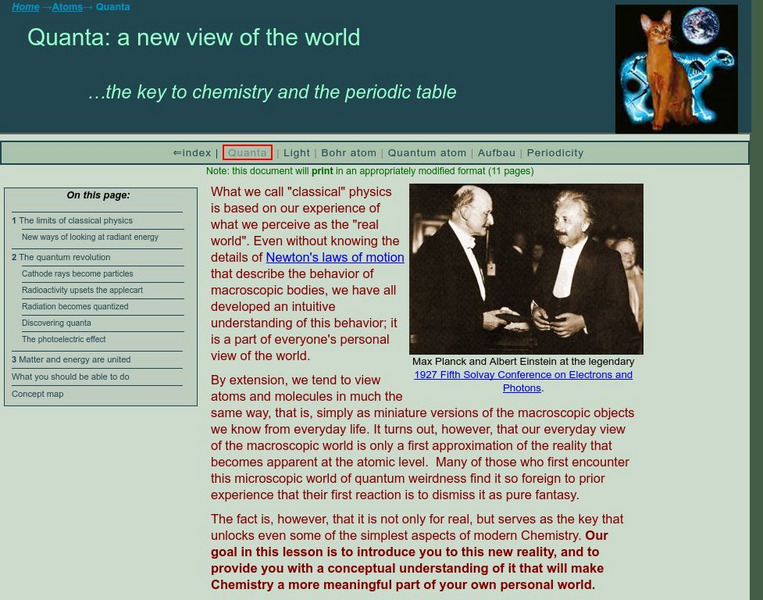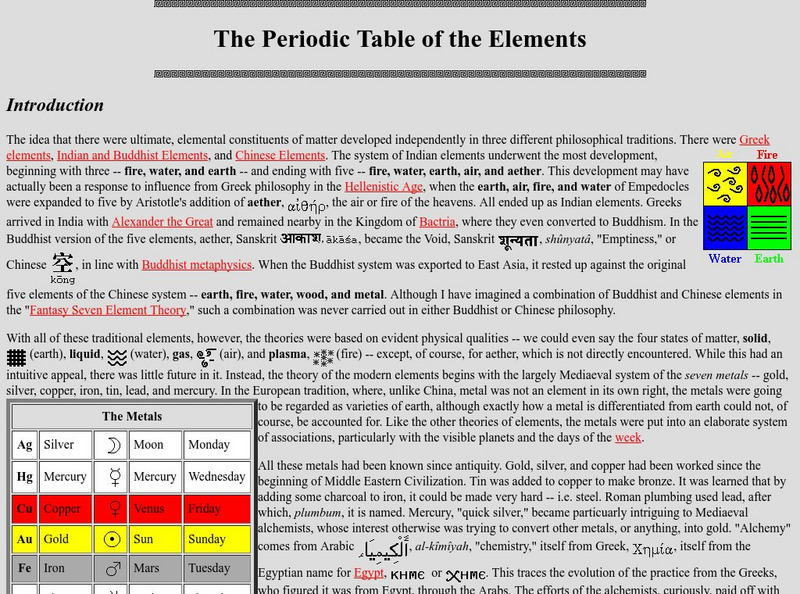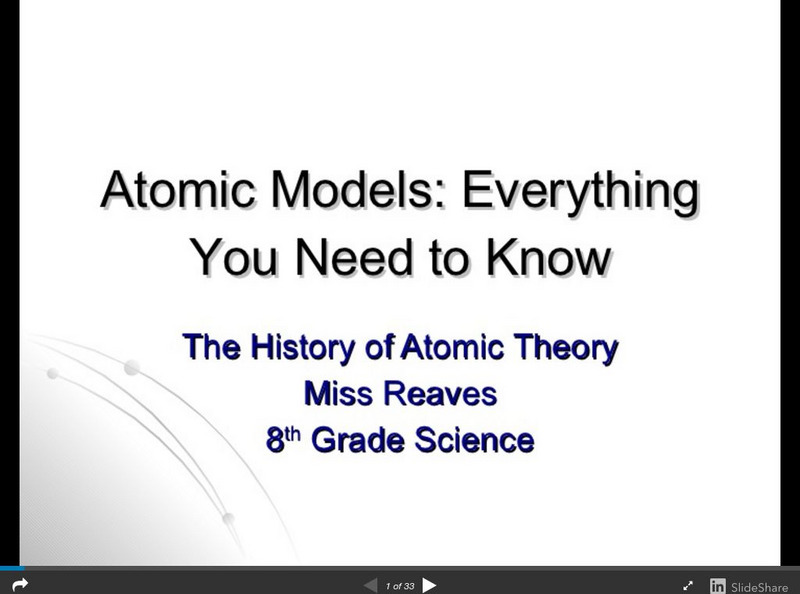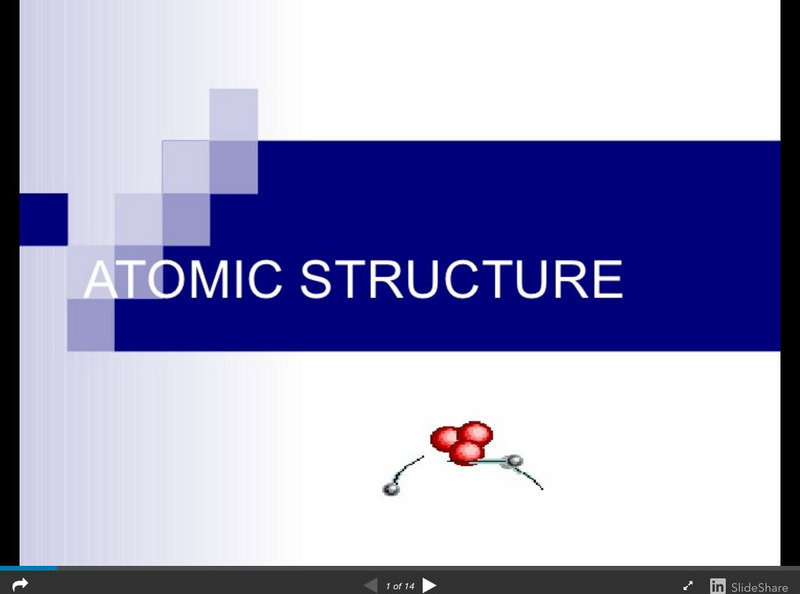Ducksters
Ducksters: Chemistry for Kids: Elements: Halogens
Explore the halogens of the periodic table. Learn about which elements are in this group and the properties, similarities, and other facts.
Ducksters
Ducksters: Chemistry for Kids: Elements Transition Metals
Kids learn about the transition metals of the periodic table. Which elements are in this group. Properties, similarities, and other facts.
Concord Consortium
Concord Consortium: Stem Resources: Spectroscopy
Web-based activity walks learners through the use of spectroscopy in determining the identity of atoms and molecules by defining the excited state of atoms, the frequencies of emitted photons, and atoms' ability to absorb them....
The Franklin Institute
Franklin Institute: Introduction to Matter
A resource provided to Grade 8 teachers to address the School District of Philadelphia's Core Curriculum on the topic of Matter. It covers properties and states of matter, elements, compounds, mixtures, atoms, and the periodic table....
Concord Consortium
Concord Consortium: Stem Resources: Atomic Structure
Introduces learners to atomic models of the past and present, focusing on the orbital model and an explanation of its basis. Learners then have the opportunity to "make an atom" and contrast it with an ion, followed by an isotope. The...
TeachEngineering
Teach Engineering: Engineering and the Periodic Table
Students learn about the periodic table and how pervasive the elements are in our daily lives. After reviewing the table organization and facts about the first 20 elements, they play an element identification game. They also learn that...
Museum of Science
The Atom's Family: Mighty Molecules
In this activity, students construct models of molecules using marshmallows and gum drops.
Thomas Jefferson National Accelerator Facility
Jefferson Lab: Element Matching Game
Use this resource to practice memorizing the names for the chemical symbols. This interactive resource has a function that will check your answers.
Chem4kids
Chem4 Kids
Here you can find all kinds of helpful information about chemistry. Learn about reactions, elements, atoms, matter, or biochemistry. Downloads and activities are also included.
Simon Fraser University
Chem1 Virtual Textbook: The Aufbau Rules
Acting as a subtopic of the General Chemistry Virtual Textbook's section on Atoms and the Periodic Table, this site discusses atomic electron configurations. Specifically, the Aufbau rules are discussed with information on energies of...
Simon Fraser University
Chem1 Virtual Textbook: The Limits of Classical Physics
Acting as a subtopic of the General Chemistry Virtual Textbook's section on Atoms and the Periodic Table, this site discusses the limits associated with classical physics. Topics covered include light and heat with additional information...
Friesian School
Fresian: The Carbon Family C, Si, Ge, Sn, Pb
This resource provides a very technical description of the 5 elements in the Carbon Family.
ClassFlow
Class Flow: What Is Matter?
[Free Registration/Login Required] Discover the composition of matter and the relationship between matter, atoms, and elements. Students will learn the differences between elements and compounds, and how molecules are formed. Chemical...
Other
Le Moyne College:elements & Atoms, Indivisible No Longer
Click to read different historical documents in chemistry related to the history of the study and discovery of radioactivity.
University of Colorado
University of Colorado: Physics 2000: Elements as Atoms: The Pauli Exclusion Principle
The Pauli Exclusion Principle shows how electrons fill atomic orbitals. Includes biographical information on Wolfgang Pauli.
University of Colorado
University of Colorado: Physics 2000: Elements as Atoms: Electron Clouds and Energy Levels
An explanation of the different types of atomic orbitals, how they are filled according to the Pauli Exclusion Principle, and how many electrons can fit in each electron shell.
University of Colorado
University of Colorado: Physics 2000: Elements as Atoms: Quantum Numbers
Each electron has a set of quantum numbers that specify it's location, orbital, and energy in a unique manner.
Crescent Public Schools
The Internet Science Room: The Periodic Table and Atomic Theory of Matter
A chemistry tutorial highlighting historical development of the atomic theory of matter and the periodic table of elements.
Ducksters
Ducksters: Chemistry for Kids: Elements: Mercury
Kids learn about the element mercury and its chemistry including atomic weight, atom, uses, sources, name, and discovery. Plus properties and characteristics of mercury.
Museum of Science
The Atom's Family: Phases of Matter
Help the Phantom choose a material and observe the changes at different temperatures in the molecule chamber. What happens to the elements or molecules as the temperature changes?
Vision Learning
Visionlearning: The Illustrated Periodic Table
Interactive concept animation shows the atomic number, weight, and structure of the first eleven elements of the Periodic Table of Elements.
Frostburg State University
General Chemistry Online: Atoms, Elements, and Ions Faq
Get the skinny on all things frequently asked about isotopes, subatomic particles and atomic theory. Find out what a "dalton" is or the difference between Na+ and Na.
Tom Richey
Slide Share: Atomic Models: Everything You Need to Know
A detailed slideshow for Grade 8 students that looks at the history of our understanding of atoms. Looks at the ideas presented by Democritus, John Dalton, J.J. Thomson, Ernest Rutherford, and Niels Bohr, and the modern-day wave model. A...
Tom Richey
Slide Share: Atomic Structure
Slideshow looking at the history of models of the atom, including those proposed by John Dalton, J.J. Thomson, Ernest Rutherford, Niels Bohr, and James Chadwick. Discusses subatomic particles, including the numbers of protons, neutrons,...
Other popular searches
- Science Elements, Atoms
- Elements and Atoms
- Atoms Elements Compounds
- Atoms Elements and Compounds
- Chemical Elements Atoms
- Candy Atoms and Elements
- Science Elements Atoms
- Science Elements and Atoms
- Physics Atoms and Elements
- Atoms Elements Review
- Chemistry Elements Atoms
- Elements Atoms



















